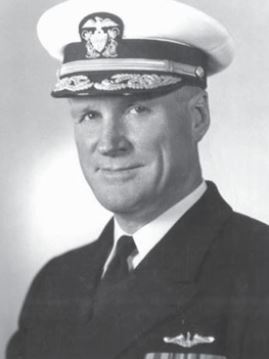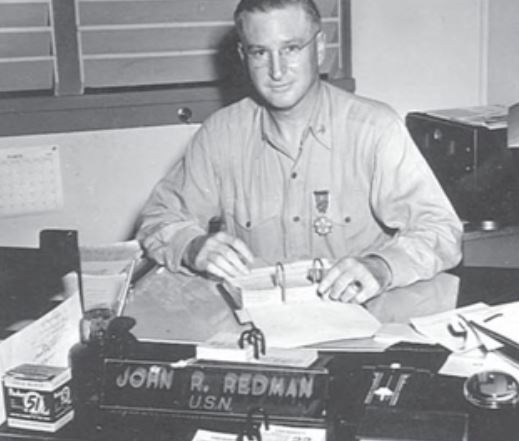The Enemies List

(Joseph Redman. Photo USN).
They say that time wounds all heals. As the secret of the code breakers emerged in the early 1970s, a lot of people piled on the revelations. The twenty-fie years since the actual events had left a mountain of misdirection and false narrative about what had happened, and it was going to take a concerted effort to correct the record. The character assassination conducted against Joe Rochefort had been successful.
I got a note from a colleague who wanted to know more about the Redman Brothers, Joe Wenger and the other careerists who pounced on Joe after the great victory at Midway.
I will leave the details to real historians like Elliott Carlson. I was more interested in what the people who were there thought. I asked Mac one time if there was a big party for the Station HYPO gang once they knew how accurate . Who were those guys, he asked, and what did they do? I sighed when I wrote back. Joe Redman was a Rear Admiral and Director of Naval Communications twice, I wrote, and his little brother John was a Navy Captain. They both made their careers on the great victory at Midway in 1942, and they stole the credit from Joe Rochefort.
The perfidy of the Brothers was concealed by the quarter-century gag rule on ultra-top secret of the ULTRA program. It was not until 1970 that the archives were cracked open on the now-ancient war, and while the historians were agog, the rest of the world had moved on.
Here is how the Redman brothers and their acolytes did it, and part of why they did it. Stephen Budiansky wrote a book called “Battle of Wits” that included this nice summary:

(John Redman. Photo USN).
Nimitz enthusiastically forwarded a proposed citation for the award to Joe of the Distinguished Service Medal to Admiral King in Washington. “Rochefort, with a keener measure of Washington politics than his commander, strongly advised against it: It would only “make trouble.” He was right. The Redmans were continuing his campaign to centralize control of all radio intelligence work under OP-20-G in Washington and Rochefort was continuing to resist; it was quickly degenerating into a fight over who deserved credit for breaking JN-25 and correctly anticipating the Japanese plans for Midway.”
Fairness alert: “The honors for breaking JN-25 were properly shared. Of the 110 vital messages broken in advance of Midway, 49 were read simultaneously by both stations, 26 by Hypo only, and 35 by Washington only. But when it came to drawing the correct conclusions from those messages, HYPO won hands down. Had Nimitz been swayed by Washington’s analysis, the Japanese ambush would very likely have succeeded. “
Yet Redman was now claiming sole credit for the victory at Midway, and in that atmosphere there was no way he could let an award for Rochefort go through without a fight. Just three weeks weeks after Midway, Redman sent a memorandum to the Vice Chief of Naval Operations baldly asserting that “experience has indicated that units in combat areas cannot be relied upon to accomplish more than the business of merely reading enemy messages and performing routine work necessary to keep abreast of minor changes in the cryptographic systems involved.”
Simultaneously, Redman’s older brother, Captain Joseph R. Redman, now Director of Naval Communications, was complaining that Station Hypo was, “by virtue of seniority, in the hands of an ex-Japanese language student” who was “not technically trained in Naval Communications.”
He went further, recommending that Joe be replaced with “a senior officer trained in radio intelligence rather than one whose background is in Japanese language.”
The Redman brothers’ treachery paid off two days later when Admiral King accepted the advice of his chief of staff and denied Rochefort the DSM, damning him with faint praise: (he) “merely efficiently used the tools previously prepared for his use,” which had a grain of truth, and that “equal credit is due” to Washington for “correct evaluation of enemy intentions,” which was a bald faced lie.
A year later, Commander John S. Holtwick, who had run the IBM machines that automated part of the agonizing process of breaking the codes at Station HYPO, made a call on Joseph Redman, now Director of Naval Communications and in charge of all Radio Intelligence. Redman casually remarked that Station HYPO had “missed the boat at the Battle of Midway,” but Washington had saved the day. The lie took Holtwick’s breath away — especially since Redman had to know that Holtwick knew the opposite was true. That was the first real inkling the Hypo crew had of how completely Washington had stolen credit for the victory.
“Remember,” Mac told me in 2010, “these were the guys who said the Japanese attack would come against Dutch Harbor in Alaska. If Admiral Nimitz had believed them, we would have lost Midway Island, and the Japanese would have consolidated an island perimeter across the Pacific that would have been hard to crack.”
The senior Redman’s memo snuck up on the real issue. After several paragraphs justifying why Radio Intelligence (the unclassified euphemism for ULTRA) should remain under the control of the Communications department where Admiral Richmond Kelly Turner put it so he could exercise direct control, rather than be subordinated to the Office of Naval Intelligence.
To put the finishing touches on the matter, Joe Redman’s baby brother John signed a letter that pounced on a formal request from Admiral Nimitz letter of 28 May 42 addressed the “inadequacy of the present intelligence section of (my) staff.”
Admiral Nimitz wanted additional resources to be placed under the intelligence department he already had, and he fully supported his intelligence officer Eddie Layton, and the analysts at Station HYPO: Jasper Holmes and Joe Rochefort. But he gave Washington the chance to twist his words. Rochefort did not get the Distinguished Service Medal he earned by handing Nimitz the greatest victory of the Pacific war.
No one could talk about what happened for twenty-five years, due to the gag order on the Big Secret. Mac looked over at me one night at Willow and said that Captain Goggins showed up to replace Joe out of the blue after Joe had been summoned back to Washington..
“He was one of the Redman Brothers home boys, wasn’t he?” I asked.
“Yep.”
“How did you work for him under those circumstances?” I said. “That was outrageous, and the office politics in Washington could have cost American lives. Potentially a lot of them!”
“We had to go on. There was a war to win,” said Mac, a little wistfully. “Layton and Holmes survived the coup, thought they tried to get him, too. The deal was that they considered Joe Rochefort to be a Naval Communications asset who was off the reservation, reporting to the 14th Naval District at Honolulu and Admiral Nimitz at Makalapa Crater. He was the sacrificial lamb to the Redman Brothers ambition.

(Joseph Wenger. Photo NSA).
By the time Eddie Layton could talk about what happened, the story was already written by people who had their own agencdas. I remember what Mac said then: “There is a building named for Joe Redman over at the Nebraska Avenue complex. I used to see it when I worked there after the war, and all I could do was mutter under my breath.”
Tommy Dyer and Jasper Holmes finally did receive the Distinguished Service Medal after the war. Rochefort finally did, too — in 1985, nine years after his death. What comes next is how Mac spearheaded the drive to make it happen.
Copyright 2015 Vic Socotra
www.vicsocotra.com
Twitter: @jayare303
